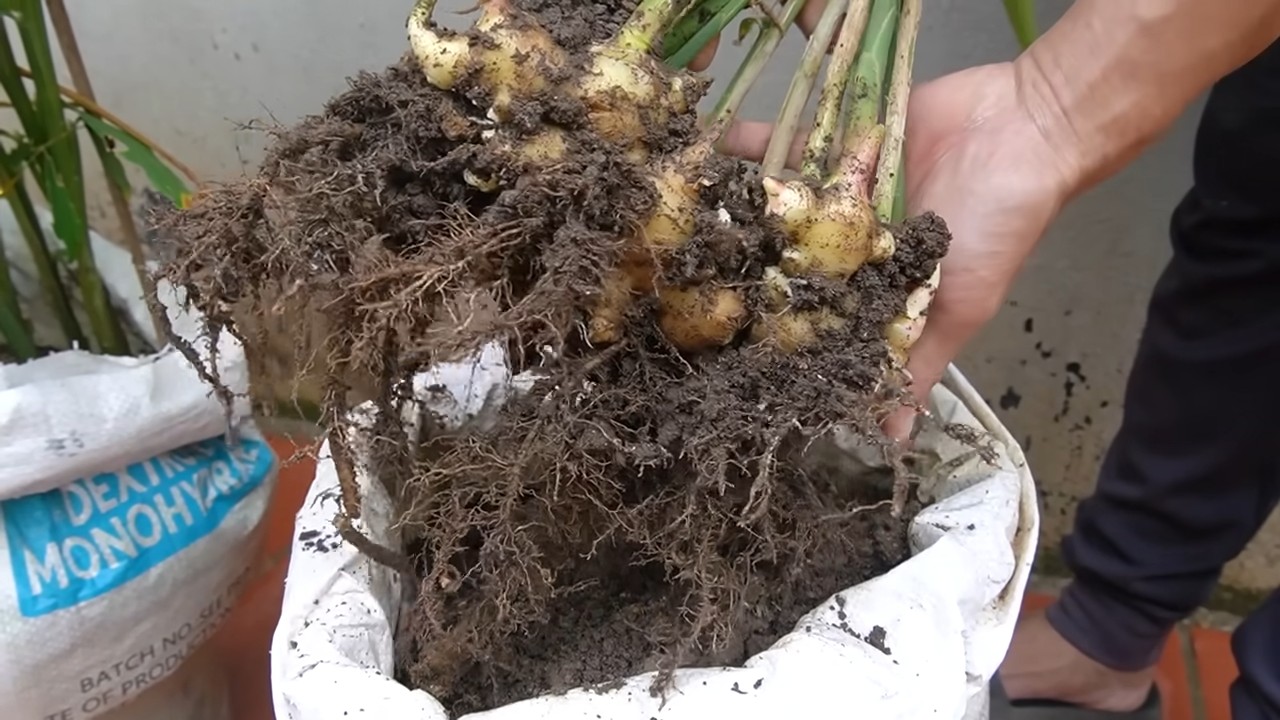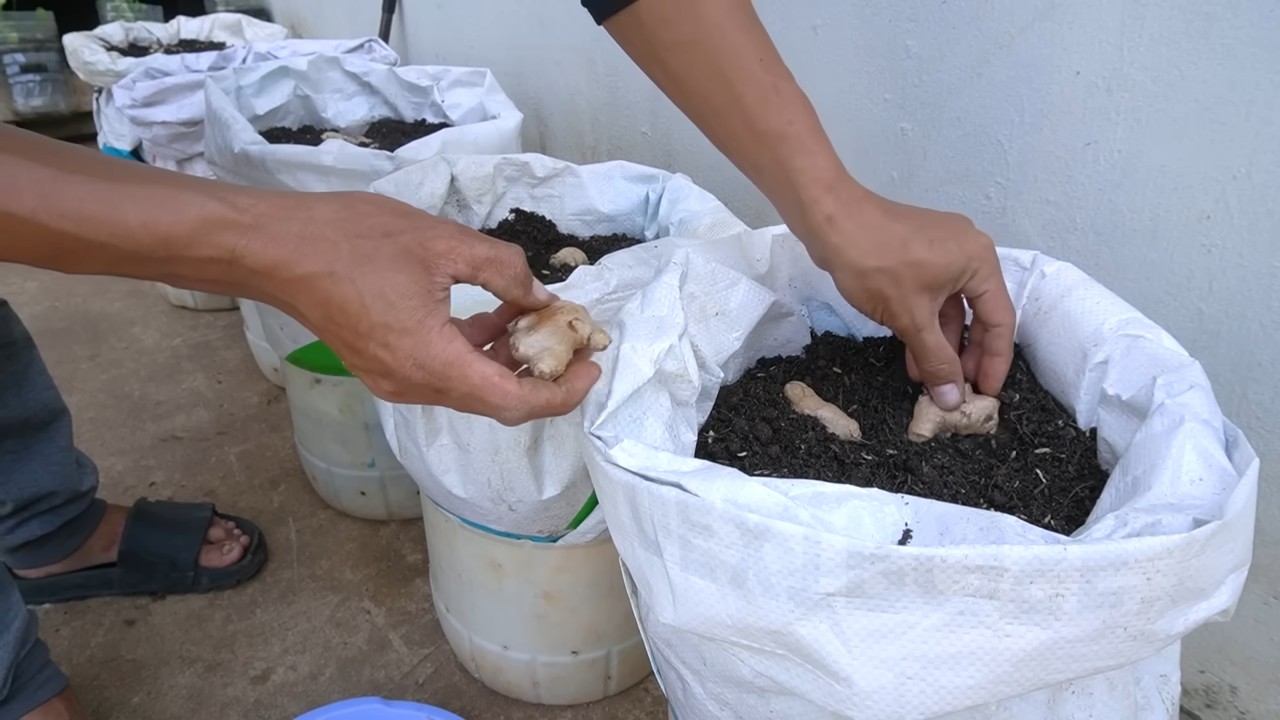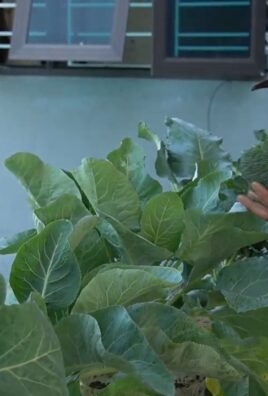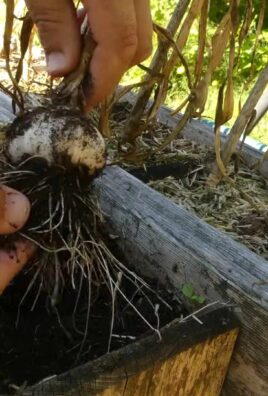Grow Ginger in Containers and unlock a world of flavorful possibilities right on your patio! Have you ever dreamed of snipping fresh ginger straight from your own plant, ready to add a zing to your stir-fries or a soothing warmth to your tea? Well, dream no more! This DIY guide will show you exactly how to cultivate this tropical treasure, even if you don’t have a sprawling garden.
Ginger, with its fiery bite and aromatic fragrance, has been prized for centuries. Originating in South Asia, it has been used in traditional medicine and culinary practices across cultures for its incredible health benefits and unique flavor profile. From ancient Ayurvedic remedies to modern-day gourmet dishes, ginger’s versatility is undeniable.
But why should you bother growing it yourself? Simple! Store-bought ginger can sometimes be lackluster, lacking the vibrant freshness of homegrown. Plus, growing your own allows you to control the entire process, ensuring organic and healthy produce. In this article, I’ll share my favorite tips and tricks for successfully grow ginger in containers, transforming your balcony or windowsill into a mini spice garden. Get ready to embark on a rewarding journey of homegrown goodness!

Grow Your Own Ginger: A Beginner’s Guide to Container Gardening
Hey there, fellow plant enthusiasts! Ever thought about growing your own ginger? It’s surprisingly easy, even if you don’t have a sprawling garden. I’m going to walk you through how to cultivate this flavorful rhizome right in your own home using containers. Get ready for fresh, homegrown ginger to spice up your cooking and drinks!
Choosing the Right Ginger and Container
Before we dive into the nitty-gritty, let’s talk about selecting the right ginger and container. This is crucial for success!
* Ginger Rhizome Selection: Look for plump, healthy-looking ginger rhizomes at your local grocery store or nursery. Opt for pieces that are firm, with visible “eyes” (small buds) on them. Avoid any that are shriveled, moldy, or have soft spots. Organic ginger is often a good choice, as it’s less likely to have been treated with growth inhibitors.
* Container Size: Ginger needs room to spread horizontally, so choose a wide, shallow container rather than a deep one. A container that’s at least 12 inches in diameter and 8 inches deep is a good starting point. You can always go bigger!
* Drainage: Drainage is key! Make sure your container has drainage holes to prevent waterlogging, which can lead to root rot.
Preparing Your Ginger for Planting
This step is all about waking up those ginger “eyes” and encouraging them to sprout.
1. Soaking the Rhizome: Soak your ginger rhizome in lukewarm water for 12-24 hours. This rehydrates it and helps stimulate growth. I usually do this overnight.
2. Cutting (Optional): If your ginger rhizome is large, you can cut it into smaller pieces, ensuring each piece has at least one or two “eyes.” Let the cut surfaces callous over for a day or two before planting to prevent rot. I find this step helpful if I want to grow multiple ginger plants.
3. Sprouting (Optional but Recommended): For faster results, you can pre-sprout your ginger. Place the rhizome in a plastic bag with some slightly damp paper towels. Seal the bag and place it in a warm, dark place. Check it every few days, misting the paper towels if they start to dry out. You should see sprouts emerging within a week or two.
Planting Your Ginger
Now for the fun part – getting your ginger into the soil!
1. Choosing the Right Soil: Ginger prefers well-draining, nutrient-rich soil. A good potting mix is essential. I like to use a mix of equal parts potting soil, compost, and perlite or vermiculite. The compost provides nutrients, while the perlite or vermiculite improves drainage.
2. Filling the Container: Fill your container with the potting mix, leaving about an inch or two of space at the top.
3. Planting the Rhizome: Place the ginger rhizome on top of the soil, with the “eyes” facing upwards. Cover it with about 1-2 inches of soil.
4. Watering: Water the soil thoroughly after planting, making sure the water drains out of the drainage holes.
Caring for Your Ginger Plant
Consistent care is essential for a thriving ginger plant.
1. Location: Ginger loves warmth and humidity. Place your container in a spot that receives bright, indirect sunlight. Avoid direct sunlight, which can scorch the leaves. An east-facing window is often ideal.
2. Watering: Keep the soil consistently moist, but not waterlogged. Water when the top inch of soil feels dry to the touch. During the growing season (spring and summer), you may need to water more frequently. Reduce watering in the fall and winter.
3. Humidity: Ginger thrives in humid environments. If you live in a dry climate, you can increase humidity by misting the plant regularly, placing a tray of water near the plant, or using a humidifier.
4. Fertilizing: Feed your ginger plant every 2-3 weeks during the growing season with a balanced liquid fertilizer diluted to half strength.
5. Temperature: Ginger prefers temperatures between 65°F and 80°F (18°C and 27°C). Protect your plant from frost and cold drafts.
6. Pest Control: Keep an eye out for pests like aphids and spider mites. If you spot any, treat them with insecticidal soap or neem oil.
Harvesting Your Ginger
The best part! Harvesting your own ginger is incredibly rewarding.
1. When to Harvest: You can start harvesting ginger about 8-10 months after planting. The leaves will start to turn yellow and die back, indicating that the rhizome is mature.
2. Harvesting Process: Gently dig around the edges of the container and carefully lift the ginger rhizome out of the soil. You can harvest the entire rhizome or just a portion of it, leaving the rest to continue growing.
3. Cleaning and Storing: Wash the harvested ginger rhizome thoroughly and let it dry completely. You can store it in the refrigerator for several weeks or freeze it for longer storage. To freeze, peel and chop the ginger, then place it in a freezer bag.
Troubleshooting
Even with the best care, you might encounter a few challenges. Here are some common issues and how to address them:
* Yellowing Leaves: This could be due to overwatering, underwatering, or nutrient deficiency. Adjust your watering schedule and fertilize your plant if needed.
* Root Rot: This is caused by waterlogged soil. Make sure your container has good drainage and avoid overwatering. If you suspect root rot, repot your plant in fresh soil.
* Lack of Growth: This could be due to insufficient sunlight, low temperatures, or poor soil. Move your plant to a brighter location, ensure the temperature is warm enough, and fertilize your plant.
* Pests: Inspect your plant regularly for pests and treat them promptly with insecticidal soap or neem oil.
Extra Tips for Success
Here are a few extra tips to help you grow the best ginger possible:
* Rotate Your Plant: Rotate your plant regularly to ensure that all sides receive equal sunlight.
* Use a Larger Container: As your ginger plant grows, you may need to repot it into a larger container.
* Experiment with Different Varieties: There are many different varieties of ginger, each with its own unique flavor and characteristics. Experiment with different varieties to find your favorite.
* Be Patient: Growing ginger takes time and patience. Don’t get discouraged if you don’t see results immediately. Just keep providing your plant with the care it needs, and you’ll be rewarded with fresh, homegrown ginger in no time!
Growing ginger in containers is a fun and rewarding experience. With a little bit of care and attention, you can enjoy fresh, homegrown ginger all year round. Happy gardening!

Conclusion
So, there you have it! Growing ginger in containers is not only achievable, but it’s also a remarkably rewarding experience. Forget relying solely on store-bought ginger; imagine the satisfaction of harvesting your own fresh, vibrant rhizomes right from your patio or balcony. This DIY project brings a touch of the exotic to your home, offering a sustainable and cost-effective way to enjoy this versatile spice.
Why is this a must-try? Because it empowers you to control the quality and freshness of your ginger. Store-bought ginger can sometimes be old or treated with chemicals. When you grow your own, you know exactly what you’re getting: organically grown, flavorful ginger ready to elevate your culinary creations and wellness routines. Plus, the process itself is incredibly engaging, connecting you with nature and providing a sense of accomplishment as you nurture your ginger plant from a small rhizome to a thriving specimen.
But the benefits don’t stop there. Growing ginger in containers opens up a world of possibilities for experimentation. Consider trying different varieties of ginger, such as the common ginger (Zingiber officinale), the ornamental ginger (Alpinia purpurata), or even the galangal (Alpinia galanga), which offers a unique, citrusy flavor. You can also adjust the soil composition to influence the flavor profile of your ginger. For a spicier ginger, try adding a bit more organic matter to the soil. For a milder flavor, use a lighter potting mix.
Furthermore, you can explore different container types. While terracotta pots are classic and allow for good drainage, plastic containers are lighter and retain moisture better. Experiment with self-watering containers to simplify the watering process, especially if you tend to forget. You can even grow ginger indoors under grow lights, extending your growing season and enjoying fresh ginger year-round.
Don’t be intimidated by the prospect of growing ginger. It’s a relatively low-maintenance plant, especially when grown in containers. With a little attention to watering, sunlight, and fertilization, you’ll be well on your way to a bountiful harvest. The key is to provide well-draining soil, consistent moisture, and protection from extreme temperatures.
We wholeheartedly encourage you to embark on this exciting DIY adventure. Start small, experiment with different techniques, and most importantly, have fun! Once you’ve harvested your first batch of homegrown ginger, you’ll be hooked.
And now, we want to hear from you! Share your experiences, tips, and tricks for growing ginger in containers in the comments below. What challenges did you face? What successes did you achieve? What unique variations did you try? Your insights will help other aspiring ginger growers and contribute to a thriving community of DIY enthusiasts. Let’s cultivate a collective knowledge base and inspire others to discover the joys of growing their own ginger. Remember, the best way to learn is by doing and sharing! So, get your hands dirty, plant some ginger, and let us know how it goes. Happy growing!
Frequently Asked Questions (FAQ)
What kind of container is best for growing ginger?
The best container for growing ginger should be large enough to accommodate the rhizome’s growth and have good drainage. A pot that is at least 12 inches in diameter and 12 inches deep is recommended. Terracotta pots are a good choice because they allow for good airflow and drainage, which helps prevent root rot. However, plastic pots are also suitable and can retain moisture better, which can be beneficial in drier climates. Regardless of the material, ensure the pot has drainage holes to prevent waterlogging. You can also use grow bags, which are lightweight and breathable, promoting healthy root development.
How much sunlight does ginger need when grown in containers?
Ginger thrives in partial shade. Direct sunlight can scorch the leaves, especially in hot climates. Ideally, provide your ginger plant with 2-3 hours of morning sun and then filtered sunlight or shade for the rest of the day. If you’re growing ginger indoors, place it near a window that receives indirect sunlight or supplement with grow lights. Rotate the pot regularly to ensure even growth. If the leaves start to turn yellow or brown, it could be a sign of too much direct sunlight.
What type of soil is best for growing ginger in containers?
Ginger prefers well-draining, fertile soil that is rich in organic matter. A good potting mix for ginger should consist of equal parts of potting soil, compost, and perlite or vermiculite. The compost provides essential nutrients, while the perlite or vermiculite improves drainage and aeration. Avoid using heavy clay soil, as it can retain too much moisture and lead to root rot. You can also amend the soil with aged manure or other organic fertilizers to boost its nutrient content.
How often should I water my ginger plant in a container?
Water your ginger plant regularly, keeping the soil consistently moist but not waterlogged. The frequency of watering will depend on the climate, the type of container, and the soil composition. In general, water when the top inch of soil feels dry to the touch. During hot, dry weather, you may need to water more frequently. Reduce watering during the dormant season (fall and winter). Overwatering can lead to root rot, so ensure the pot has good drainage and avoid letting the plant sit in standing water.
When is the best time to harvest ginger grown in containers?
You can start harvesting ginger about 8-10 months after planting. The leaves will start to turn yellow and die back, indicating that the rhizomes are mature. To harvest, gently dig around the plant and lift the rhizomes from the soil. You can harvest the entire plant or just a portion of the rhizomes, leaving the rest to continue growing. Freshly harvested ginger has a more delicate flavor and aroma than store-bought ginger.
Can I grow ginger indoors in a container?
Yes, you can successfully grow ginger indoors in a container. Choose a large pot with good drainage and use a well-draining potting mix. Place the pot near a window that receives indirect sunlight or supplement with grow lights. Maintain a consistent temperature between 65-75°F (18-24°C) and provide adequate humidity. You can increase humidity by misting the plant regularly or placing a tray of water near the pot. Water regularly, keeping the soil moist but not waterlogged.
What are some common problems when growing ginger in containers and how can I fix them?
Some common problems include root rot, yellowing leaves, and pest infestations. Root rot is caused by overwatering and poor drainage. To prevent it, ensure the pot has good drainage and avoid overwatering. Yellowing leaves can be caused by too much direct sunlight, nutrient deficiencies, or pests. Move the plant to a shadier location, fertilize with a balanced fertilizer, and inspect for pests. Common pests include aphids, spider mites, and mealybugs. Treat infestations with insecticidal soap or neem oil.
How do I store harvested ginger?
Freshly harvested ginger can be stored in the refrigerator for several weeks. Wrap the rhizomes in a paper towel and place them in a plastic bag or container. You can also freeze ginger for longer storage. Peel and chop the ginger into small pieces or grate it before freezing. Store the ginger in an airtight container or freezer bag. Frozen ginger can be used directly from the freezer without thawing. Another option is to pickle the ginger in vinegar or brine.
Can I grow ginger from store-bought rhizomes?
Yes, you can grow ginger from store-bought rhizomes, but it’s important to choose rhizomes that are plump, firm, and have visible buds (eyes). Soak the rhizomes in water overnight before planting to encourage sprouting. Avoid using rhizomes that are shriveled, soft, or have no buds. Organic ginger is often a better choice as it is less likely to have been treated with growth inhibitors.
What kind of fertilizer should I use for growing ginger in containers?
Use a balanced fertilizer with a ratio of 10-10-10 or 20-20-20. You can also use an organic fertilizer such as compost tea or fish emulsion. Fertilize every 2-3 weeks during the growing season (spring and summer). Reduce or stop fertilizing during the dormant season (fall and winter). Follow the instructions on the fertilizer label for proper application rates.





Leave a Comment